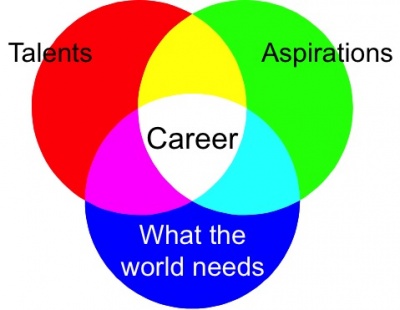A Few Parting Thoughts about Victory for Physician-Scientists
I have been doing a lot of thinking about physician-scientist careers with the transition to my new responsibilities as Chair of Pediatrics at the University of Pittsburgh. This thinking has been stimulated in part by lots of conversations with students and colleagues about what constitutes an optimum career (or optimum outcome for training grant applications) for a physician-scientist. In other words, what defines victory?
The training of a physician-scientist incorporates attainment of competencies in medicine and research and, if done well, provides instruction and experience in leadership, compassion, and empathy. There are numerous careers that can build on this foundation and seem to me appropriate for physician-scientists. But how does one choose? And do they all represent victory?
I think the choice of a career comes from the intersection of three sets in a Venn diagram (see the figure). The first is defined by your talents, i.e., what you are good at. Sometimes we need help with an assessment of our talents from an objective colleague or mentor, as sometimes we think we are more talented in a certain area than we actually are, and sometimes we take for granted talents that we truly have. The second is defined by your aspirations, i.e., what you find most fulfilling or what you love to do. Aspirations should be entirely your own and reflect what gives you the most professional satisfaction and joy. I think of fulfillment as the many days I drive home from work in the evening as tired as I could possibly be, but I would not trade that day for any other. Although you may need some exposure to different types of careers to populate this set, the final cut should be yours and yours alone to make. The third is defined by what the world needs. There are so many world needs that can be met by a physician-scientist (e.g., making discoveries, caring for patients, teaching others, formulating policies, communicating to the public, or enabling any of these activities, among many others) that this set likely will encompass virtually any physician-scientist career choice. By bringing together your talents and aspirations to help with what the world needs, you have your career.
But is it really that easy? Well, yes and no. This career choice algorithm is certainly straight-forward, but it is important to keep in mind that all three sets, talents, aspirations, and what the world needs, change with time. As you progress in your career, you get better at some things (and worse at others) and evolve in your appreciation of what is most fulfilling. What the world needs is also dynamic, which means that the career-choice Venn diagram requires revision from time-to-time. This process can be challenging, as it requires reexamination of closely held values and goals, and it may lead to completely new career directions. Don’t be afraid to ask your mentors to help you define the next steps in your career path. Mentors can point to latent talents that should be encouraged, raise awareness about new aspirations that should be considered, offer new insights into what the world needs, and suggest times to reevaluate the career Venn diagram. And be grateful for these opportunities, as these reinventions can catalyze substantial personal and professional growth.
Let me close with a few words about the importance of leadership in physician-scientist careers. I have come across many definitions of leadership, but one that I find most satisfying is to bring together others who share your passion to effect constructive change. Physician-scientists, by virtue of their training and experience, have opportunities to lead in many professional endeavors. Capitalizing on these opportunities allows a physician-scientist to have the biggest possible career impact by multiplying the talents and aspirations of others. Viewed from this perspective, nothing could be more victorious for a physician-scientist career than the application of talents and aspirations to lead constructive change in a domain that the world needs. The most effective way to do this will vary for each of you, and that is to be celebrated.

Fig. 1 A career is the sweet spot at the intersection of talents, aspirations, and what the world needs.